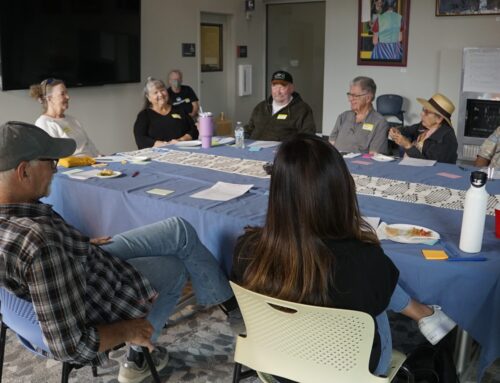
Deferred maintenance on the Santa Cruz Municipal Wharf is expected to cost $14 million, city leaders said. (Stephen Baxter — Santa Cruz Local file)
SANTA CRUZ >> Following a three-year legal battle, the Santa Cruz City Council on Tuesday advanced plans to renovate the Santa Cruz Municipal Wharf. The plan aims to draw more tourists and money needed for $14 million in repairs.
The approved master plan includes:
- An East Promenade for pedestrians and cyclists, expected to be constructed in the next 2-5 years.
- An events pavilion, more shops and an expanded lifeguard headquarters.
- Two new landings for small boats and larger vessels up to 200 tons.
- A welcome center near the wharf entrance.
The approved plan omits a proposed walkway deck on the west side of the wharf and a 40-foot “landmark” building, both subjects of litigation and community pushback.
The council would need to approve more detailed plans before any projects in the master plan are built, said David McCormic, development manager of the city’s economic development office. The document’s approval does not “close the door on community engagement,” McCormic said.
Repairs and deferred maintenance for the wharf could cost more than $14 million, McCormic said. That figure does not include projects in the master plan. The new master plan would allow city leaders to seek state and federal money for repairs, said McCormic.
“It’s not an easy task to catch up on this, and we don’t have the resources to get there,” McCormic said.
The council voted 7-0 to:
- Adopt a revised version of the plan without the western walkway and landmark building.
- Direct staff to work with the California Coastal Commission to create a strategy to carry out the plan.

The Wharf Master Plan includes two new boat landings, a promenade for pedestrians and cyclists, an expanded lifeguard headquarters and more shops. The plan approved by the Santa Cruz City Council on Tuesday does not include the landmark building or the westside walkway. (Roma Design Group)
Plan background
Wharf maintenance is mostly funded by taxes on businesses on the wharf, but revenues have been “on a downward trend over the past seven, eight years,” said McCormic. In recent years, the city has subsidized wharf operations with about $1.5 million per year for maintenance, parking and other services, he said.
An updated master plan for the wharf was proposed in 2016. Following community pushback, the city completed a full environmental review of the plan.
The city council approved a new wharf master plan with an environmental review in November 2020. Soon after, the plan was challenged by community group Don’t Morph the Wharf, which focused objections on two elements of the plan:
- A walkway on the west side of the wharf about 12 feet above sea level.
- A “landmark building” at the end of the wharf up to 40 feet tall.

The Wharf Master Plan approved Tuesday excludes a ‘westside walkway’ and a ‘landmark building’ proposed near the end of the wharf. (Roma Design Group)

A ‘landmark building’ in early wharf plans was excluded from a plan approved by the Santa Cruz Council on Tuesday. (Roma Design Group)
The lawsuit by the group argued that the plan would block access to sea-lion viewing holes. In December 2023, a superior court judge ruled that city leaders provided insufficient evidence that the plan would not curtail public recreation.
Don’t Morph the Wharf leaders agreed not to pursue more legal challenges if the city council removed the building and the walkway from the plan, said Gillian Greensite, a Don’t Morph the Wharf member, during Tuesday’s council meeting.
The plan presented by city staff Tuesday included a new environmental review with more details about the potential impacts of the proposals and potential places where new sea-lion viewing holes could be built. The review concluded that a walkway would not take away opportunities for public recreation.
The walkway would have provided more opportunities for wildlife viewing and fishing access, McCormic said. It could also “serve as a fender” by deflecting debris and softening waves before they hit the main wharf, according to a staff report.
Public, councilmember support
Peter Drobac, owner of wharf restaurants Riva Fish House and Makai Island Kitchen and Groggery, said he hoped the plan would bring more visitors to wharf businesses.
“To be blunt, it is a decaying and underutilized asset right now,” Drobac said. “It has the potential to be so much more than what it is.”
Retired wharf supervisor Jon Bombaci said the council should include the western walkway in the plan to protect the wharf from waves that are “tearing at it right now.”
Multiple residents said they supported a plan without the landmark building and the western walkway. “I do agree the wharf needs to be updated, but we can do it in a mindful way,” said Andrea Rosenfeld. “And we can do things that are a better fit for this community.”
Several council members said they favored approval of the plan without the walkway or landmark building to avoid further lawsuits and delays to wharf maintenance.
“It’s been too long,” said Councilmember Shebreh Kalantari-Johnson. “There’s a lot of work that needs to be done. And we owe it to the businesses on the wharf, we owe it to ourselves as a community, and we owe it to our visitors to do the best that we can and move forward.”
Questions or comments? Email [email protected]. Santa Cruz Local is supported by members, major donors, sponsors and grants for the general support of our newsroom. Our news judgments are made independently and not on the basis of donor support. Learn more about Santa Cruz Local and how we are funded.
Jesse Kathan is a staff reporter for Santa Cruz Local through the California Local News Fellowship. They hold a master's degree in science communications from UC Santa Cruz.





